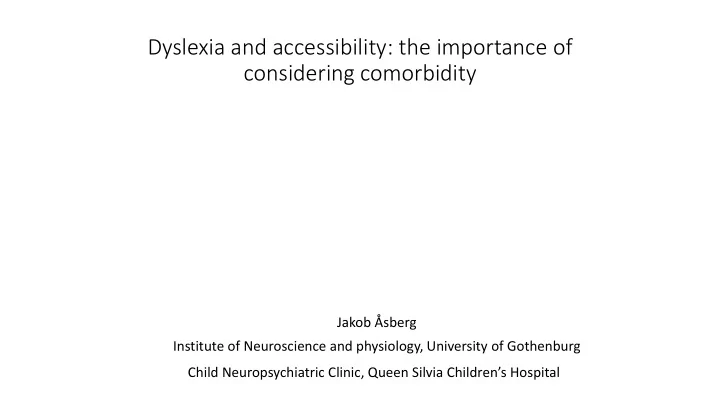

Dyslexia and accessibility: the importance of considering comorbidity Jakob Åsberg Institute of Neuroscience and physiology, University of Gothenburg Child Neuropsychiatric Clinic, Queen Silvia Children’s Hospital
Accessibility: “the quality of being able to be reached or entered.” (society/school/curriculum) “the quality of being easily understood or appreciated.”
Dyslexia • Part of the specific learning disorder diagnosis (alongside reading comprehension, math and/or writing difficulties) • Impaired single word reading (and spelling) • Usually not diagnosed in intellectual disability, severe traumatic brain injury and poor sensory acuity (”unless better accounted for by…”) • Prevalence approx 5-8% (depending on exclusion criteria and cut off on a continuous trait) • Associated with phonological language problems, but often multiple cognitive deficits • Under substantial genetic influence • Training, compensation and understanding
“ Our study of students’ strategies for coping with recurrent academic failure strongly confirms that the main goals of dyslexic students are related to protecting their self- esteem”
Accessibility, participation and coping seem to go hand-in-hand: …“ social relationships at work where the attitudes and support of the employer and co-workers are important; working conditions with factors like the availability of assistive technology and accommodations on the job, and personal factors like self- disclosure and coping strategies”
• SDS (“Short dyslexia scale”, Åsberg Johnels & Lundström) was completed by parents of 1,688 nine-year-old twins as part of a telephone inventory that also included the full A-TAC (Autism, ADHD, Tics, and other comorbidities) (Hanson et al., 2005) interview. Examples… “He / she has a hard time spelling” “He / she has a harder time learning to read than what you would expect considering how the child learns other things.” “He / she had difficulty learning the letters of the alphabet” “He / she needs extra help in reading” • We excluded individuals with ICD-10 NPR diagnoses of intellectual developmental disability/mental retardation (F70-F79, n = 9), blindness and no vision (H54, n = 9), and hearing loss (H90-H91, n = 14; WHO, 1992).
Findings Not yet published….
Will a more precise definition of dyslexia help? In some case-control studies "attempts are made to select 'pure' clinical cases that do not show signs of comorbid disorders. In practice, however, even when this is attempted it is only ever likely to be partly successful. Furthermore, if comorbidities between different disorders are as pervasive as recent evidence suggests, the selection of "pure" cases may be practically impossible (too many tests would need to be given to each child), perhaps theoretically impossible (excluding all comorbidities will result in no ‘pure’ cases to study), and if it can be done at all such an approach will result in the selection of children who are unrepresentative of the group of children […] we set out to study” ( Hulme and Snowling, 2009)
ESSENCE and ”dyslexia plus” ESSENCE (Gillberg, 2010) • ”Co -occurring difficulties” is the rule rather than exception in kids with NDDs. • The current focus on specific conditions/disabilities in legislative, research and clinical contexts “has led to a situation in which the diffuseness of disorder has come to be underestimated”. • Stuck in health care silos. • ”Autism plus”
”Autism plus” “Perhaps it is almost exclusively when autistic traits – even when pronounced – are conjoined with such other problems that the total amount of problems becomes such that the high support need becomes apparent and diagnosing becomes a way of getting appropriate interventions. Recently I have begun to refer to this group as ‘Autism Plus’ to distinguish the clinically significant cases from ‘Autism Pure’ (i.e. autism without comorbidity), which most often lack clinical importance, at least in early childhood” ( Gillberg).
” Dyslexia plus”?
There is some evidence that the “plus bit” in dyslexia makes a big difference… “Children with comorbid problems have more secondary problems, such as low self -esteem, behavioral problems, and dropping out of school, and a worse outcome compared with children diagnosed with only ADHD or RD” ( Germano et al., 2010) Likewise, McArthur, Castles, et al. (2016) concluded “that poor readers with multiple impairments in reading, language, and attention are at higher risk for low academic and general self- concept […] In contrast, poor readers with typical spoken language and attention did not have low self-concept of any type ”
What special considerations are needed for the ”plus part” in dyslexia - plus in order to secure accessibility? • If not team based assessment nsure referral if needed – “diagnostic shadowing” is problematic from an “ESSENCE perspective”. • My experience is often that the more complex the child’s ”problems”, the less systematic support is provided for the child’s reading problems in school – absurd! • The same ”phonics” training recommended in the general dyslexia literature appears to work according to the research evidence (Tamm et al., 2017; Arcuili et al., 2017)! • Assistive technology likely helpful (Gruner et al., 2017) – but needs help with access, and usage? • Allowing for movement – do not sit still and concentrate?! • How to promote adaptive coping with academic challenges (accept help, regulate mood/frustration, find motivation, refrain from self-handicapping or giving up, etc.)?
Thank you! psyjaas@psy.gu.se
Recommend
More recommend